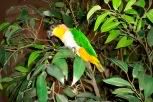I came across this interesting study while surfing the internet:
These Caique parrots belong to John McMichael.
These are "yellow-thighed caiques" and their scientific name is "Pionites leucogaster xanthomeria". These photographs came about as a result of an email that John McMichael sent me that went as follows: "I own and breed a species of parrot known as a caique. I am interested in some pictures of them made using UV photography. These birds have apricot colored feathers that fluoresce a bright yellow under a black light. I have made a crude attempt to photograph this fluorescence. This, however, has proved a challenge since they seem to get agitated when illuminated by the black light and refuse to sit still. Thus, I had to use the fastest color film I could find (1800 ASA) and I wonder if the results could be better.
I would also like to have some pictures made of them with UV reflectance photography. This species is monomorphic. I keep wondering if both sexes still look the same in reflected UV light. Birds are able to see into the near UV, so they may be able to discern sex in this way. I was wondering if you might be interested in this." I replied that this would indeed be of interest to me and the rest is history. So far we have photographed these birds twice. The second time only for fluorescence and this time using a lighter toned backdrop (Photos 4, 5 and 6) but since it did not fluoresce it did not change the tone of the background significantly.
Anyway, you can find out a LOT more about these birds at John McMichael's website located here: www.caiquesite.com
The camera that was used for these photographs was a Canon A1 with a 100mm f/2.8 Canon FD lens. The parrots were first photographed using 3200K Tungsten illumination on Kodak Vericolor Portra film using the camera's metering sytem to determine the shutter speed and aperture automatically.
Next, since they naturally exhibit strong UV excited fluorescence, they were illuminated by a Sunpack 555 flash (operating at full power) whose reflector was covered with a Wratten 18A filter. To keep ultraviolet away from the film and allow only visible wavelengths through the lens was covered with a Wratten 2E filter. The scene was recorded on Kodak Extachrome 400 speed film at an aperture of f/2.8 with the flash-to-subject distance being adjusted from about 12" - 36" from the birds to achieve the equivalent of bracketing.
Finally, to record the reflectance of UV radiation from the bird's feathers, the lens was covered with the Wratten 18A filter to allow only UV through to the film. The lens was focused on the birds but the focus point was brought opposite the infrared mark (as suggested in my article: Guidelines for UV and IR photography). The flash was located on a bracket attached to the camera and both were thus about 4 feet from the birds. The best aperture at that distance was something like f/5.6 based on a series of bracketed exposures. The film for this was Kodak TMax 400 processed in Rodinal 1:25 for 6 minutes at 68 degrees with agitation every 30 sec.

This is a pair of nominate race WBC's

Caiques under UV lighting

Caiques by reflected UV light
for more pictures, please visit: Exhibit- Caiques
Hopefully informal studies like these will soon be taken more seriously in the avicultural world, as caiques are one of the least studied parrots that are currently kept as pets. The more we know about them, the better we can care for them.





0 Responses to "Glowing Caiques"
Post a Comment